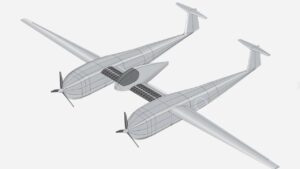Born of the heritage of the Solar Impulse Foundation and taking it further, Climate Impulse wants to showcase concrete technologies that can revolutionize the aviation industry, and the mobility sector in general.
Two Well-Travelled Partners
We are all familiar with the exploits of Bertrand Piccard, which include the first circumnavigations of the globe in a balloon and more recently in a solar aircraft. He comes from a family of explorers who have climbed the heights and plumbed the depths of our world. We are probably less familiar with an equally intrepid adventurer, Raphael Dinelli.
Dinelli attempted a solar circumnavigation of the globe as part of the 1996-1997 Globe Vendee competition. He didn’t quite make it full circle, sinking in the Indian Ocean. The Australian Air Force dropped a life raft to him and then he was pulled to safety by another competitor, Peter Goss. According to Wikipedia, “He went on to sail with Goss in the 1997 edition of the two person transatlantic race Transat Jacques Vabre where they won their class. He then went on to compete in the 2000, 2004 and 2008 editions of the Vendee Globe. In 2007, he founded the Ocean Vital Foundation, of which he is the director of research.”
His design of a tandem wing biplane with extreme stagger (lower wing far ahead of upper wing) was to fly on solar power and algae-derived fuel. As a final approach, Dinelli used Total fuel to run the generator in his craft. Later, he came up with a joined wing airplane, Eraeole 2. We show 1 and 2 in quick succession.
Although Eraole 2 may be no more than a design so far, Dinelli’s association with Piccard may have a more solid outcome. As the Solar Impulse Foundation web site reports, “Bertrand Piccard unveils his new emission-free project: a green hydrogen-powered airplane to fly non-stop around the Earth, demonstrating how concrete solutions can help build a cleaner and more efficient world. With science company Syensqo (a spinoff of Solvay) as the main partner of this technological, environmental and human adventure, the limits of innovation will be pushed back to enable the development of the airplane, built in France by engineer and navigator Raphaël Dinelli.”
Climate Impulse
The proposed craft will be a twin fuselage, center pod, twin-motored machine propelled with green hydrogen. Pilots will be housed in the relatively large, comfortable-looking pod

Climate Impulse’s “flight plan” details when project will reach major milestones
According to Syensqo, tailor-made materials, films and adhesives will be developed for Climate Impulse and used in the structure, fuselage, wings and hydrogen tanks to provide lightness, alongside mechanical and thermal properties.
High-performance materials for the Proton Exchange Membranes and binders for electrodes of the fuel cell will also provide high-power density and efficiency from the fuel cell and enable a more compact design of the plane.
“In this world full of eco-anxiety, we need to restore hope and stimulate action by demonstrating disruptive solutions that lead to sustainable progress,” said Piccard. “More than flying around the world with a hydrogen aeroplane, Climate Impulse will explore new ways of thinking and acting to promote a better quality of life.”

Pilots sit in a pod between two large fuselages atop high-aspect-ratio wing
We have a 160-year legacy of pushing the limits of science for the benefit of society. We’ve always believed in Bertrand Piccard’s dreams and want to make them true. Ilham Kadri, CEO Syensqo
All of the productive elements will be managed under the overall technical supervision of 49Sud, which will also handle solar cells encapsulation, the power block for the hydrogen drive system, and construction and assembly of the the final craft. Airbus will provide security and the flight test program will be run by 49Sud with Daher and the DGAC, the French Civil Aviation Authority. Dassault will create the digital twin for verifying and validation how components fit together and provide technical software for the project.
Safran will provide the electric motors and several other firms will craft associated systems. Climate Impulse is a complex project and at least as Andre Borschberg’s Solar Airship One. The Impulse should make its trip around the world in nine days. The airship should take 20, a leisurely tour of a world that can happily receive more such clean approaches to providing energy without guilt and an economy reliant on saving us all.
We’ll follow both projects with great interest, and release details as they become available.

